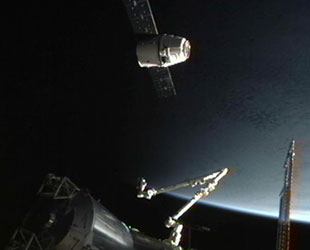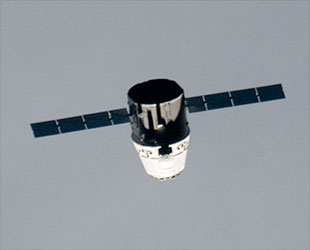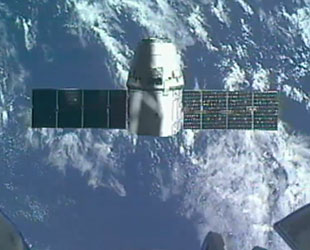May 25, 2012 — For the first time in history, a privately developed and launched spacecraft is now attached to the International Space Station (ISS).
The Dragon cargo capsule, which was designed and built by California-based Space Exploration Technologies, or SpaceX, was berthed to the nadir, or Earth-facing, side of the orbiting complex's Harmony node at 11:02 a.m. CDT (1602 GMT) on Friday (May 25), three days following its launch from Cape Canaveral, Florida, and about two hours after astronauts used the station's robotic arm to capture the unmanned spacecraft.
"This has been the culmination of an enormous amount of work by the SpaceX team in partnership with NASA and we're incredibly excited," Elon Musk, SpaceX's CEO and chief designer said. "Really, I don't have words enough to express the level of excitement and elation we feel here at SpaceX for having this work."
"There's so much that could have gone wrong, and it went right," Musk continued. "We were able to overcome some last-minute issues with some fast thinking at [both] NASA mission control and SpaceX mission control and got it there."
"It's just a fantastic day, a great day for the country, and for the world," Musk said. "This really is, I think, going to be recognized as a significant historical step forward in space travel. Hopefully the first of many to come."

SpaceX's Dragon during its final approach to the space station at a distance of about 32 feet (10 m) below the complex. (NASA TV) |
Now that the Dragon is secured to the station, the orbiting laboratory's crew will work to open the hatches separating the two spacecraft and begin unpacking the capsule of its supplies on Saturday. The Dragon has aboard about 1,000 pounds (460 kilograms) of cargo and equipment, including 15 student-designed science experiments and food for the station's six-person crew.
The second spaceflight under NASA's Commercial Orbital Transportation Services (COTS) program, Dragon's arrival at the space station brings SpaceX a giant step closer to beginning regular deliveries of supplies to the station. The company has a $1.6 billion contract with the U.S. space agency to provide a dozen Dragon cargo ship flights to the station, not counting this test flight.
NASA is relying on privately-operated spacecraft, like the Dragon and others now being developed, to offer robotic supply deliveries and, eventually, astronaut-crewed flights to and from the orbiting outpost now that its space shuttle fleet is retired.
"I can't tell you how proud we are to have been part of this historic moment," Michael Suffredini, NASA's program manager for the International Space Station, said. "Many times as the manager of this program I have stood in front of you and spoken about historical moments, things that we have done that have never been done before and this rates right at the top."
Steps to station
As this was its first flight to the space station, the Dragon needed to pass several communications and navigation tests before NASA's Mission Control in Houston ultimately gave its "go" for the spacecraft to move in close enough for the station's 58-foot (18-meter) robotic arm to reach out and grapple it.
On Thursday, the 12-foot (3.7 meter) wide, solar-powered capsule demonstrated that it could rendezvous with the station, passing under the orbiting complex at a distance of 1.5 miles (2.5 kilometers). The "fly-under" also tested the space station crew's ability to send commands to the spacecraft by remotely turning on an exterior strobe light and verified that the Dragon's thermal imaging and laser ranging sensors were working.

The SpaceX Dragon approaches the space station the day before its berthing for a series of communication and navigation tests. |
Then on Friday, after flying a loop around the station to set-up for its first attempt at berthing, the Dragon began a stepped approach to the outpost, moving closer and then holding its distance until Mission Control gave the "go" to proceed. At 820 feet (250 meters) from the complex, the Dragon demonstrated it could retreat from the station, a needed precaution that proved useful as it neared closer.
After verifying that the Dragon's navigation sensors were calibrated at a distance of 660 feet (200 meters), SpaceX commanded the spacecraft to move within the "Keep Out Sphere," the safety zone surrounding the station, but soon after ordered an unplanned retreat.
The Dragon's laser ranging system incorrectly locked onto stray reflections from the station's Japanese Experiment Module, rather than its grapple target, necessitating that SpaceX back the Dragon away and then narrow its field of view.
With that small setback resolved, the Dragon was cleared to proceed to its final advances, moving to just 98 feet (30 meters) and then 32 feet (10 meters) from the station, its capture point.
NASA astronaut Don Pettit, working with European Space Agency (ESA) astronaut and fellow flight engineer Andre Kuipers, commanded the station's Canadarm2 robotic arm to grab hold of the Dragon at 8:56 a.m. CDT (1356 GMT).

Capture is confirmed: The station's robotic arm latched onto the Dragon spacecraft, capturing it for its berthing. (NASA TV) |
"It looks we've got us a Dragon by the tail," radioed Pettit, who then joked, "we are thinking this sim went really well and we're ready to turn it around and do it for real."
"Congratulations on a wonderful capture," capcom Megan Behnken said from Mission Control in Houston. "You have made a lot of folks happy here and over in Hawthorne and right here in Houston. Great job guys."
The crew members then manipulated the arm to position and attach the spacecraft to Harmony. NASA astronaut Joe Acaba, working with a laptop computer in the station's Destiny laboratory, issued the commands that secured the bolts holding Dragon to the station.
Dragon aboard
The Dragon will remain at the station until May 31, when — packed with supplies for their return to Earth — it will be detached and directed to re-enter the atmosphere for a parachute-assisted splashdown in the Pacific Ocean off the coast of San Francisco.
SpaceX is targeting the launch of its first cargo resupply service (CRS) flight later this year.

SpaceX's Dragon spacecraft seen during its final approach to the International Space Station on May 25, 2012. (NASA TV) |
The Dragon now belongs to the small club of international spacecraft that have visited the orbiting outpost, including NASA's space shuttles, Roscosmos' Soyuz and Progress capsules, ESA's Automated Transfer Vehicles (ATV), and the Japan Aerospace Exploration Agency's or JAXA's H-II transfer vehicles (HTV).
The first commercial visiting vehicle, Dragon will be far the last. Orbital Sciences Corporation's Cygnus cargo craft is targeted to follow later this year. Orbital, like SpaceX, has a contract with NASA to provide resupply services for the space station.
NASA also has funded agreements with four companies (and unfunded agreements with two more) to advance its Commercial Crew Development (CCDev) program, aimed at launching its astronauts on commercially-developed spacecraft. SpaceX's Dragon is among the competitors for that contract, which also includes the Boeing Company's CST-100 spacecraft, Sierra Nevada Corp.'s Dream Chaser and Blue Origin's yet-to-be-named orbital capsule.
